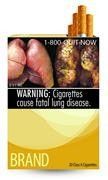Usefulness of Grim Anti-Smoking Warnings Doubted

Mandatory anti-smoking warnings on U.S. cigarette packs are being challenged, this time by researchers who say the combination of grotesque images and explicit messages may not be effective in curbing smoking.
As health communicators search for the best strategy to help smokers quit their addiction, four of America's top tobacco companies have staged a legal campaign to overturn the Food and Drug Administration's new labeling regulations, slated to take effect Sept. 22, 2012.
The new study, published in the Journal of Media Psychology and conducted by faculty at the University of Missouri School of Journalism, aims to shed some light on the effectiveness of such graphic labeling on the smoker's psyche.
The study says the campaign seems to rely on smokers' discretion alone to interpret the grim images, and they could backfire.
Glenn Leshner, Paul Bolls and Kevin Wise, co-directors of the Psychological Research on Information and Media Effects Lab, write that television public service announcements that included either a threatening message or a disgusting image resulted in greater attention, better memory and a heightened emotional response.
But PSAs that included both threatening and disgusting images caused participants to have defensive responses, where reactions were so strong that the participants unconsciously shut down processing the messages. They also had poorer memories and lower emotional responses when the threatening PSAs included disgusting images.
Leshner said, When a disgusting image is included in a threatening PSA, the ad becomes too noxious for the viewer. ... We noticed in our collection of anti-tobacco public service announcements a number of ads that contained very disturbing images, such as cholesterol being squeezed from a human artery, a diseased lung, or a cancer-riddled tongue. Presumably, these messages are designed to scare people so that they don't smoke. It appears that this strategy may backfire.
Bolls explained, Simply trying to encourage smokers to quit by exposing them to combined threatening and disgusting visual images is not an effective way to change attitudes and behaviors. Effective communication is more complicated than simply showing a disgusting picture. That kind of communication will usually result in a defensive avoidance response where the smoker will try to avoid the disgusting images, not the cigarettes.
Bolls added, You have to talk to smokers in a meaningful and encouraging way that outlines the consequences of smoking, but also have messages designed to minimize the defensive avoidance responses.
But another study at Susquehanna University in Selinsgrove, Pa., found, in contrast, that graphic images on cigarette packs did reduce demand.
In the study, a sample size of around 400 adult smokers from the U.S. participated in an experimental auction of cigarette packs that had four different types of warning labels; all packs, however had the same message details on Smoking causes mouth cancer. The displayed message varied on each of the pack in terms of the text, placement of the message and the imagery.
Study co-author Matthew Rousu, a professor of economics, said, Demand was significantly lower for packs with grotesque images, with the lowest demand associated with the plain, unbranded pack. ... The bids for cigarette packs that had a grotesque photo and no brand imagery received bids that were 17 percent lower than the bids for the package with the current U.S. warning label.
Results from our study suggest that the new health warnings with graphic pictures will reduce demand for cigarettes, he said. He added that regulators should consider health warnings with graphic images, but also plain packaging policies for tobacco products.
Bloomberg reported on Michael Siegel, a professor of community health sciences at the Boston University School of Public Health, who suggests that a better approach for the U.S. could be to follow the law being proposed in Australia.
Beginning July next year, cigarette packs in Australia will be required to carry graphic warnings. But, in Australia, the law would require for the rest of the pack to be blank, with only the brand name written in a small, plain font. No logos, no color. Siegel writes, Because the pack's design plays such a critical role in establishing the brand's identity, the empty half could, over the long term, erode the cigarette makers' ability to make their brand appealing.
© Copyright IBTimes 2024. All rights reserved.





















